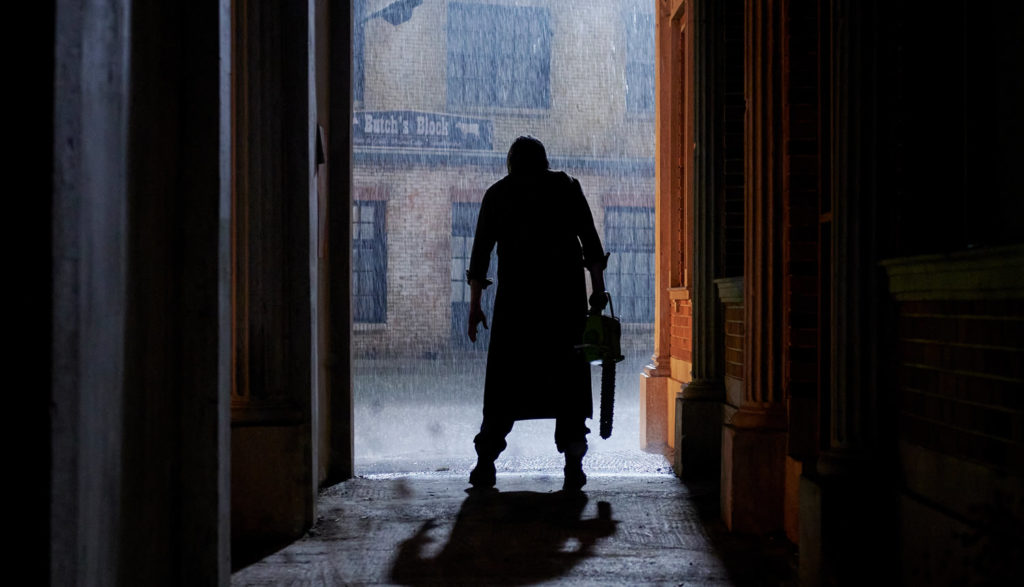
Harlow, Texas. The perfect little ghost town to revitalize.
That’s what Melody and Dante think, at least. Because the town’s abandoned, they were able to purchase a lot of the buildings for cheap. Now that they’ve got investors, they plan to sell the properties to people who want to leave the turmoil of the big city and make a fresh start.
“This is a chance for people to start fresh somewhere without the violence and the madness—somewhere safe,” Melody tells Lila, her sister.
Little does Melody know just how unsafe they are in Harlow. You see, about 50 years ago, five people were attacked by a chainsaw-wielding madman just outside Austin, Texas—and only one survived. But when authorities went to look for the killer, he had vanished into hiding.
Right into the ghost town of Harlow.
Lila and Melody would do anything to protect each other. Each one consistently puts herself in harm’s way in order to save the other, and they put some personal grievances aside when the situation is dire.
The movie also shows us how people aren’t always who we think they are. Richter, the local handyman hired to help restore Harlow, is initially pegged by the protagonists and the ominous music score as a dangerous maniac because of his open-carry firearm and the cloud of diesel smoke he sprays on their car as he zooms by down the road.
However, when the chainsaw-wielding antagonist known as Leatherface arrives and decides to start hunting people down, Richter steps in to help and to protect the others, showing us that just because people may not hold the same views as us doesn’t automatically make them an enemy.
Sally, upon finding evidence that Leatherface was in the area, begins repeating “I fear no evil” to calm herself, potentially a reference to Psalm 23.
None.
It goes without saying that a movie with the subtle nuance of a title called Texas Chainsaw Massacre would be more shocking if it didn’t have any violent content. If you aren’t sure how violent a massacre is, the main villain’s whole schtick is that he wears the carved-off faces of people he’s murdered, if that’s any indication for you. Viewers should expect to see limbs go flying, organs making surprise appearances and heads getting bashed.
In a documentary about the original Texas Chainsaw Massacre which occurred 50 years prior, we see footage of bodies and blood. This is a foretaste of the things to come: Leatherface murders many people onscreen in gruesome and gory detail. He snaps the wrist of a man before stabbing him in the throat, and he shoots another before bashing his head with an oxygen tank. Leatherface also uses knives and shards of glass to slice stomachs and cut faces and throats. As a result of one of these encounters, we see the bloody muscles exposed on the side of a man’s face.
Leatherface uses a cleaver as a weapon of choice as well, and he snaps a man’s leg in half in a battle with it before crushing his skull. Another character is hit with it when Leatherface throws the cleaver at her. A decapitated head is thrown at a crowd.
A literal busload of people gets slaughtered with a chainsaw, and the movie takes time to show us all the revolting ways the moviemakers could think of for how to murder people. During this montage, we see severed limbs, pools of blood and people cut in half, all in grotesque detail. One character is decapitated by a chainsaw onscreen. Leatherface chainsaws another character by lifting them over his head with the weapon. He also tries to drown a character.
In another scene, we watch as Leatherface carves mother Ginny’s face off and wears it. Melody stabs Leatherface with a corkscrew. Sally and Lila shoot and stab Leatherface. Melody turns a chainsaw on Leatherface.
Ginny has a heart attack and dies, causing Leatherface to go into a rampage. A brief flashback shows a school shooting. In that flashback, we hear gunshots and people screaming, and we see Lila laying on the blood-covered floor surrounded by bodies. Ginny’s faceless body is shown.
We hear nearly 35 f-words, occasionally preceded by “mother.” There are 11 uses of the s-word. “D–n,” “b–ch,” “d–k” and “h—” are all used as well. A woman derogatorily refers to black people as “negroes.” God’s name is misused 14 times, occasionally followed by “d–n.” Jesus’ name is inappropriately used three times.
Lila purchases a corkscrew and references champagne to Melody. People celebrate with alcoholic beverages on a bus. Lila smokes a cigarette with handyman Richter, and Richter is often seen smoking.
A background newspaper headline reads “More Bodies Discovered on Slaughter Property.” Slaughter is the surname of the of the cannibal family from The Texas Chainsaw Massacre: The Next Generation.
A truck plays heavy metal music. Leatherface’s mother Ginny throws up. Sally cuts open a hanging dead pig. Melody is covered in sewage by an exposed pipe.
In the lore of The Texas Chainsaw Massacre franchise, Leatherface is described as a mentally challenged child in the body of a man due to years of inbreeding. We also learned that he had been manipulated by his cannibalistic family to kill.
In that sense, he was depicted a mindless weapon driven by obedience to his controlling and evil family. The majority of his murders were because he was scared of the outside world, and strangers kept walking through his family’s property. Though his actions were by no means justifiable, the killer’s primary motivation was fear of the unknown and fear of familial retribution if he disappointed them—not pure unadulterated evil.
In this version of Texas Chainsaw Massacre, however, that character, and those motivations, go out the window. Here, Leatherface’s motivation is wrath. He watches his mother Ginny die of a heart attack due to a misunderstanding between herself and Melody. That sends Leatherface into an unbridled rage and a desire to kill anything that moves—which moves him more into the category of Michael Myers from Halloween, whose character stands as evil personified.
Someone could potentially argue that Leatherface’s motive in this movie is revenge for the death of his mother. And while this argument perhaps make sense for a couple characters who unintentionally cause Ginny’s death, it doesn’t explain his motive for slaughtering countless others who die in this movie.
What this movie does do is show us how good Leatherface is at chainsawing people. He chainsaws them here. He chainsaws them there. He’s the only person in the world who can bring a chainsaw to a gun fight in the state with the highest number of registered firearms and still come out on top.
And man, is it bloody. Horror movies have never shied away from showing the audience disgustingly graphic deaths, but Texas Chainsaw Massacre relishes in it, intentionally showing the audience just how much the filmmakers must’ve enjoyed biology class. There are lost limbs, severed heads, gruesome knife wounds, and, of course, people chainsawed in half.
Unfortunately, it seems the whole point of the film is to show death and gore in the most horrific of ways for the sake of showing death and gore.


Kennedy Unthank studied journalism at the University of Missouri. He knew he wanted to write for a living when he won a contest for “best fantasy story” while in the 4th grade. What he didn’t know at the time, however, was that he was the only person to submit a story. Regardless, the seed was planted. Kennedy collects and plays board games in his free time, and he loves to talk about biblical apologetics. He thinks the ending of Lost “wasn’t that bad.”